Design of Broadband Power Amplifier with Enhanced Concurrent Efficiency for Wireless Communication
Abstract
1. Introduction
2. Broadband PA with Baseband Impedance Control
2.1. Concurrent Dual-Band PA with Non-Zero Baseband Impedance
2.2. Broadband PA with Baseband Impedance Control for Concurrent Operation
3. Design and Simulation Results
3.1. Broadband PA Design
3.2. Single-Tone Simulation Results
3.3. Concurrent Two-Tone Simulation Results
4. Measurement Results
5. Conclusions
Author Contributions
Funding
Data Availability Statement
Conflicts of Interest
References
- Tao, M.; Chen, Y.; Kong, W.; Ni, S.; Zheng, Z.; Xia, J. Design of dual-mode multi-band Doherty power amplifier employing impedance-and-phase constrained optimization. Electronics 2025, 14, 2078. [Google Scholar] [CrossRef]
- Wei, Z.; Liu, H.; Yang, X.; Jiang, W.; Wu, H.; Li, X.; Feng, Z. Carrier aggregation enabled integrated sensing and communication signal design and processing. IEEE Trans. Veh. Technol. 2024, 73, 3580–3596. [Google Scholar] [CrossRef]
- Li, J.; Chen, W.; Huang, F.; Feng, Z. Multiband and multimode concurrent PA with novel intermodulation tuning network for linearity improvement. IEEE Microw. Wirel. Compon. Lett. 2018, 28, 248–250. [Google Scholar] [CrossRef]
- Saad, P.; Colantonio, P.; Piazzon, L.; Giannini, F.; Andersson, K.; Fager, C. Design of a concurrent dual-band 1.8–2.4-GHz GaN-HEMT Doherty power amplifier. IEEE Trans. Microw. Theory Tech. 2012, 60, 1840–1849. [Google Scholar] [CrossRef]
- Liu, W.; Liu, Q.; Du, G.; Li, G. Analytical dual-band matching approach for concurrent high-efficiency power amplifiers. IEEE Trans. Circuits Syst. II Express Briefs 2022, 69, 4769–4773. [Google Scholar] [CrossRef]
- Der, A.T.; Barton, T.W. C/Ka concurrent dual-band GaN MMIC based on shorted quarter-wavelength line topology. IEEE J. Microw. 2024, 4, 372–380. [Google Scholar] [CrossRef]
- Wei, L.; Chen, F.; Zhang, Z. Design of dual-band power amplifier based on microstrip coupled-line bandstop filter. AEU-Int. J. Electron. Commun. 2024, 183, 155381. [Google Scholar] [CrossRef]
- Cai, Q.; Che, W.; Ma, K.; Gu, L. A Concurrent dual-band high-efficiency power amplifier with a novel harmonic control network. IEEE Microw. Wirel. Compon. Lett. 2018, 28, 918–920. [Google Scholar] [CrossRef]
- Brinkhoff, J.; Parker, A.E. Effect of baseband impedance on FET intermodulation. IEEE Trans. Microw. Theory Tech. 2003, 51, 1045–1051. [Google Scholar] [CrossRef]
- Chen, X.; Chen, W.; Ghannouchi, F.M.; Feng, Z.; Liu, Y. Enhanced analysis and design method of concurrent dual-band power amplifiers with intermodulation impedance tuning. IEEE Trans. Microw. Theory Tech. 2013, 61, 4544–4558. [Google Scholar] [CrossRef]
- Shariatifar, M.; Jalali, M.; Abdipour, A. Design of a high-efficiency dual-band class-J/J power amplifier considering concurrent mode input drive. Int. J. RF Microw. Comput. Aided Eng. 2019, 30, e22064. [Google Scholar] [CrossRef]
- Bunz, B.; Ahmed, A.; Kompa, G. Influence of envelope impedance termination on RF behaviour of GaN HEMT power devices. In Proceedings of the European Gallium Arsenide and Other Semiconductor Application Symposium, GAAS 2005, Paris, France, 2–3 October 2005; pp. 649–652. [Google Scholar]
- Barros, D.R.; Nunes, L.C.; Cabral, P.M.; Pedro, J.C. Impact of the input baseband terminations on the efficiency of wideband power amplifiers under concurrent band operation. IEEE Trans. Microw. Theory Tech. 2019, 67, 5127–5138. [Google Scholar] [CrossRef]
- Nunes, L.C.; Barros, D.R.; Cabral, P.M.; Pedro, J.C. Efficiency degradation analysis in wideband power amplifiers. IEEE Trans. Microw. Theory Tech. 2018, 66, 5640–5651. [Google Scholar] [CrossRef]
- Qi, T.; He, S.; Hu, B.; Liu, C.; Du, X.; Zhao, Y.; Helaoui, M.; Chen, W.; Ghannouchi, F.M. Efficiency analysis of concurrently driven power amplifiers. IEEE Access 2020, 8, 91379–91393. [Google Scholar] [CrossRef]
- Huang, H.; Yu, C.; Wu, Y.; Jin, Q.; Fan, C.; Gao, J.; Liu, Y. Analysis and design of a novel concurrent class B/J continuum power amplifier. Int. J. RF Microw. Comput. Aided Eng. 2020, 30, e22275. [Google Scholar] [CrossRef]
- Shariatifar, M.; Jalali, M.; Abdipour, A. A concurrent dual-band continuous Class-F power amplifier with intermodulation impedance tuning: Analysis and design technique. AEU-Int. J. Electron. Commun. 2019, 111, 152899. [Google Scholar] [CrossRef]
- Liu, J.; Shi, W.; Zang, Y.; Hua, J.; Xu, G.; Hu, C.; Liu, K.; Li, Y.; Li, M. Analysis and design of concurrent class-F2 power amplifier based on power-series technique. AEU-Int. J. Electron. Commun. 2025, 193, 155722. [Google Scholar] [CrossRef]
- Yao, Y.; Dai, Z.; Li, M. A novel topology with controllable wideband baseband impedance for power amplifiers. Front. Inf. Technol. Electron. Eng. 2024, 25, 308–315. [Google Scholar] [CrossRef]
- Liu, K.; Shi, W.; Lu, N.; Li, Y.; Liu, J.; Zang, Y.; Hu, C.; Li, M. Broadband Doherty power amplifier with baseband impedance control for concurrent application. AEU-Int. J. Electron. Commun. 2025, 191, 155680. [Google Scholar] [CrossRef]

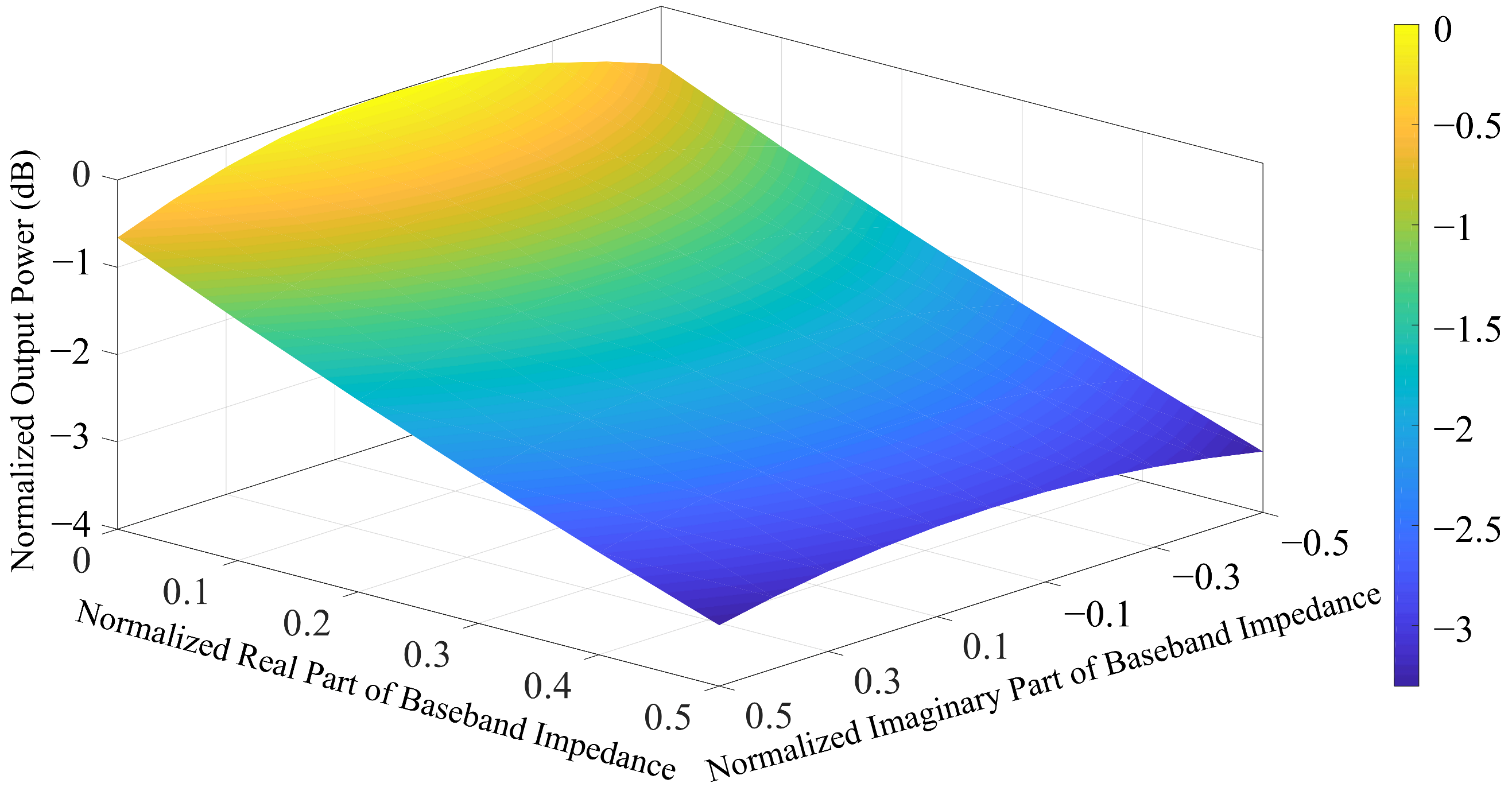
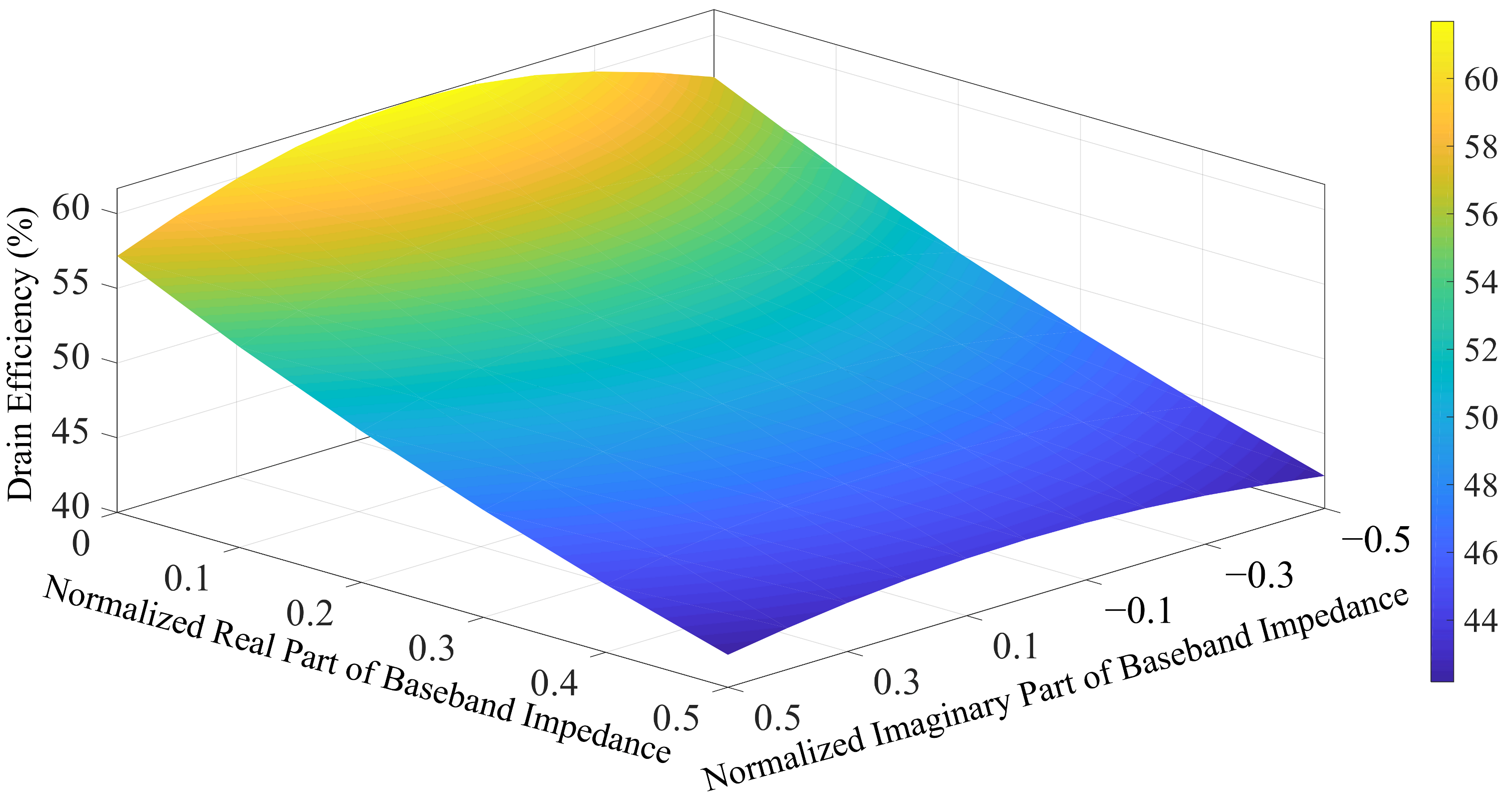

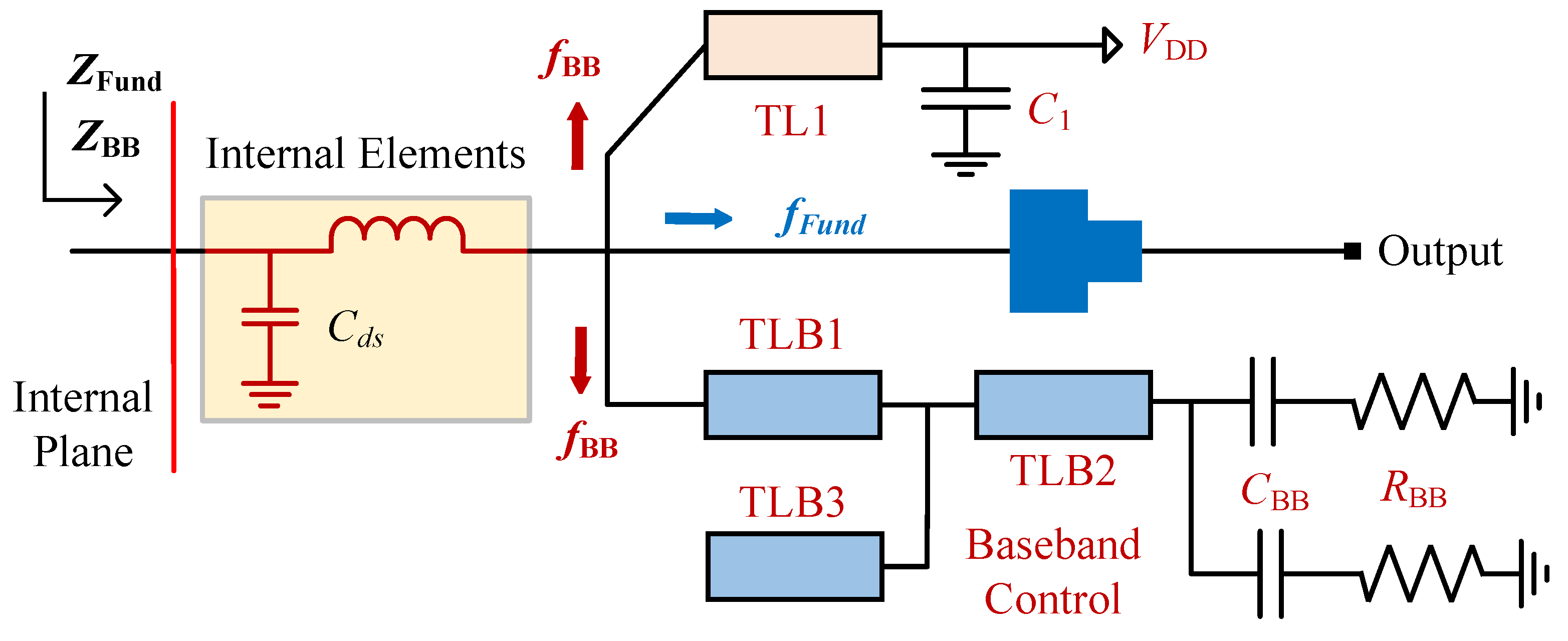
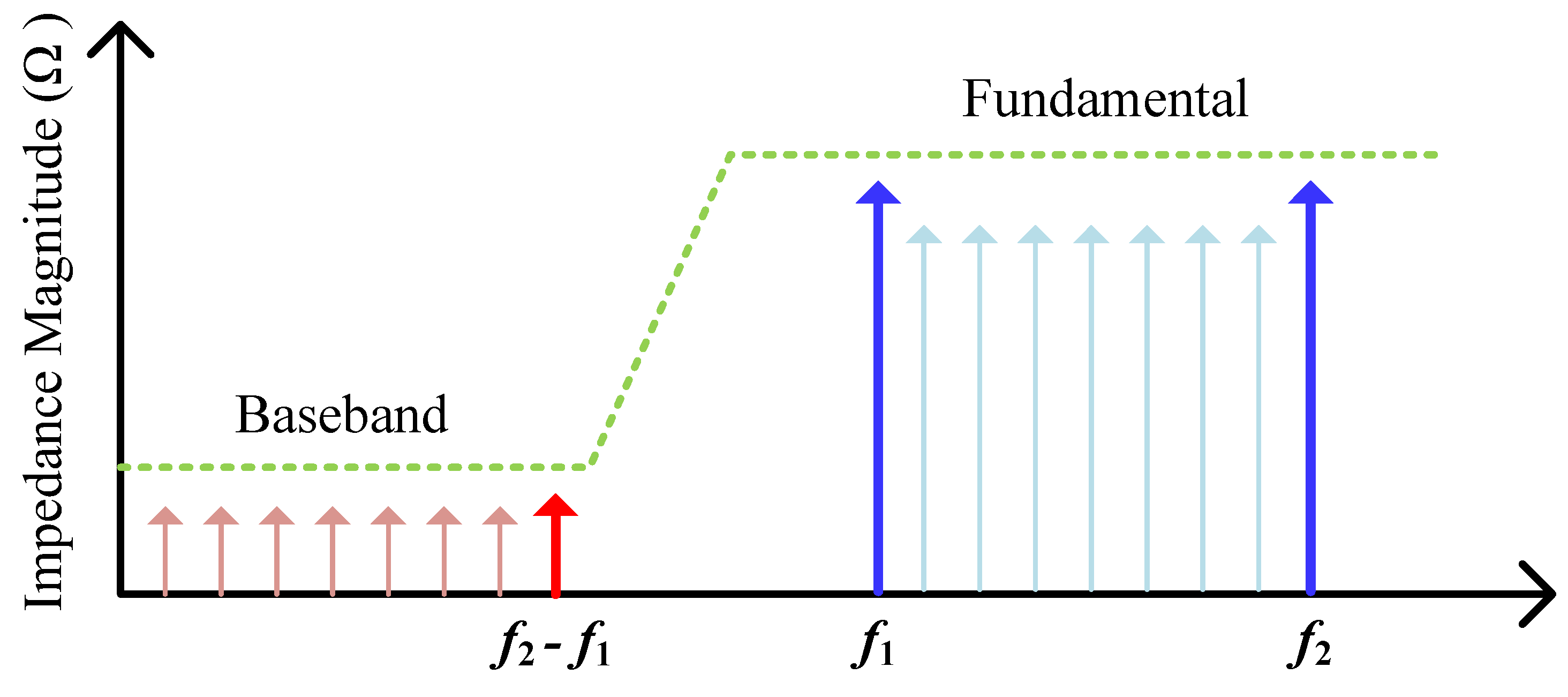

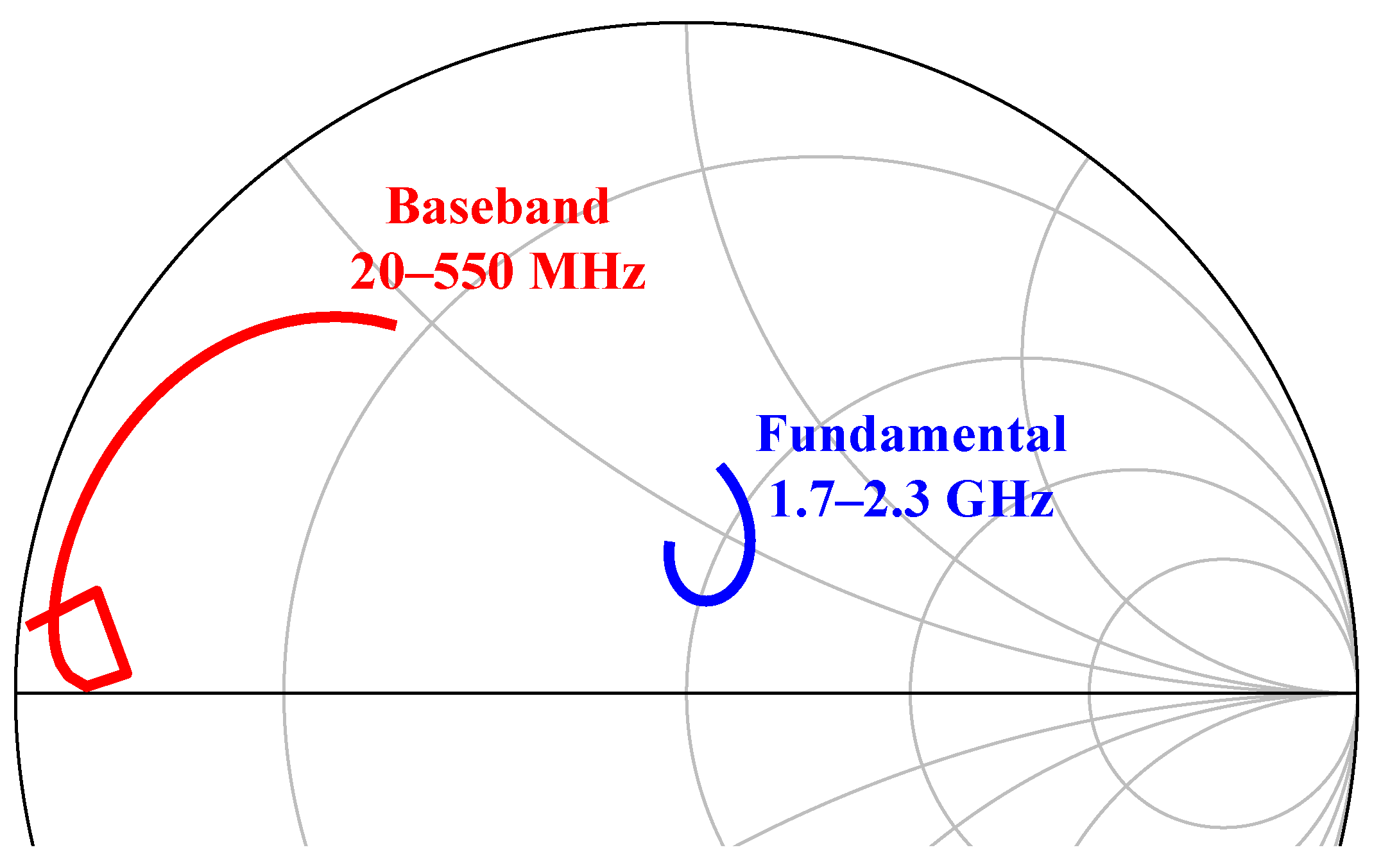
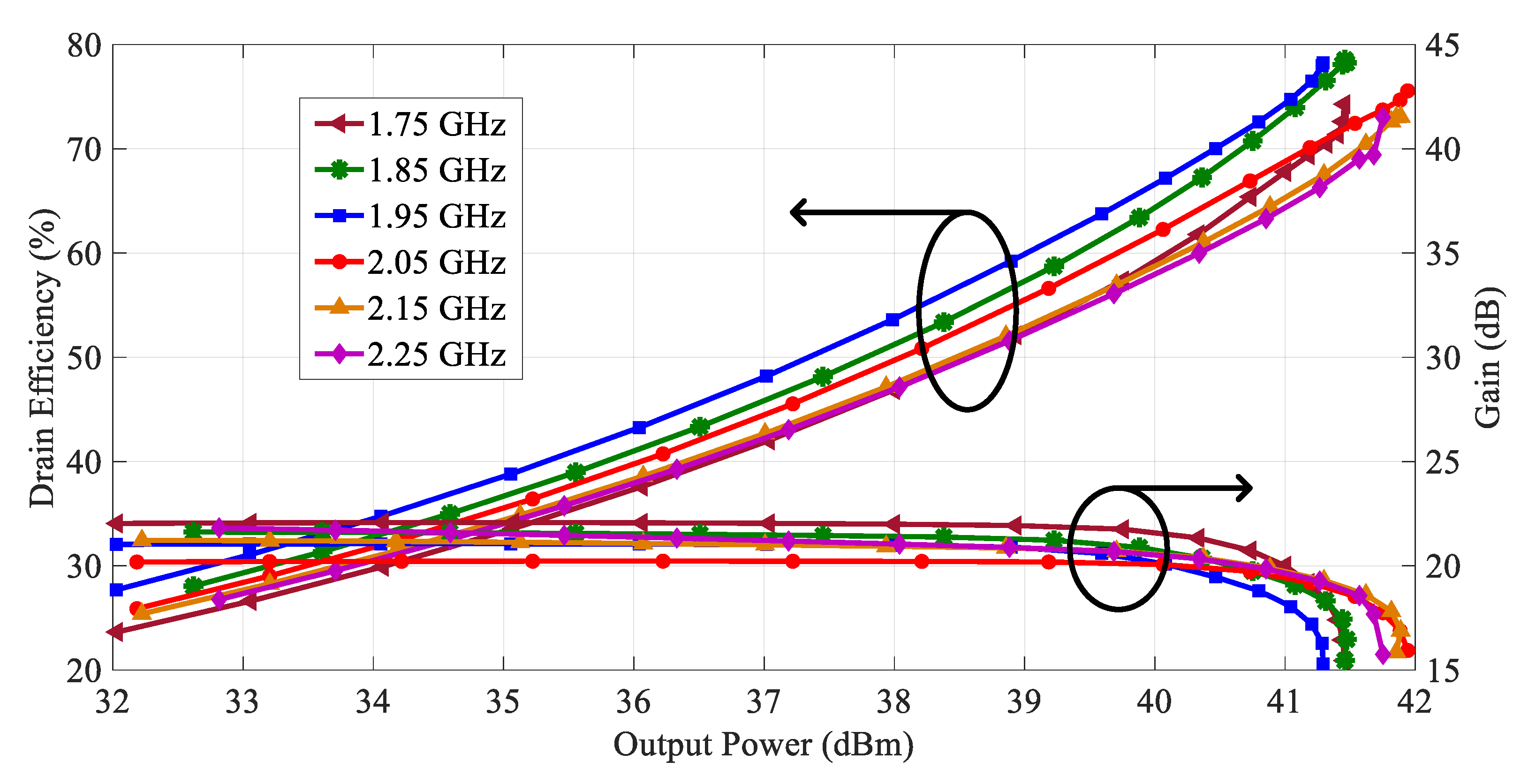
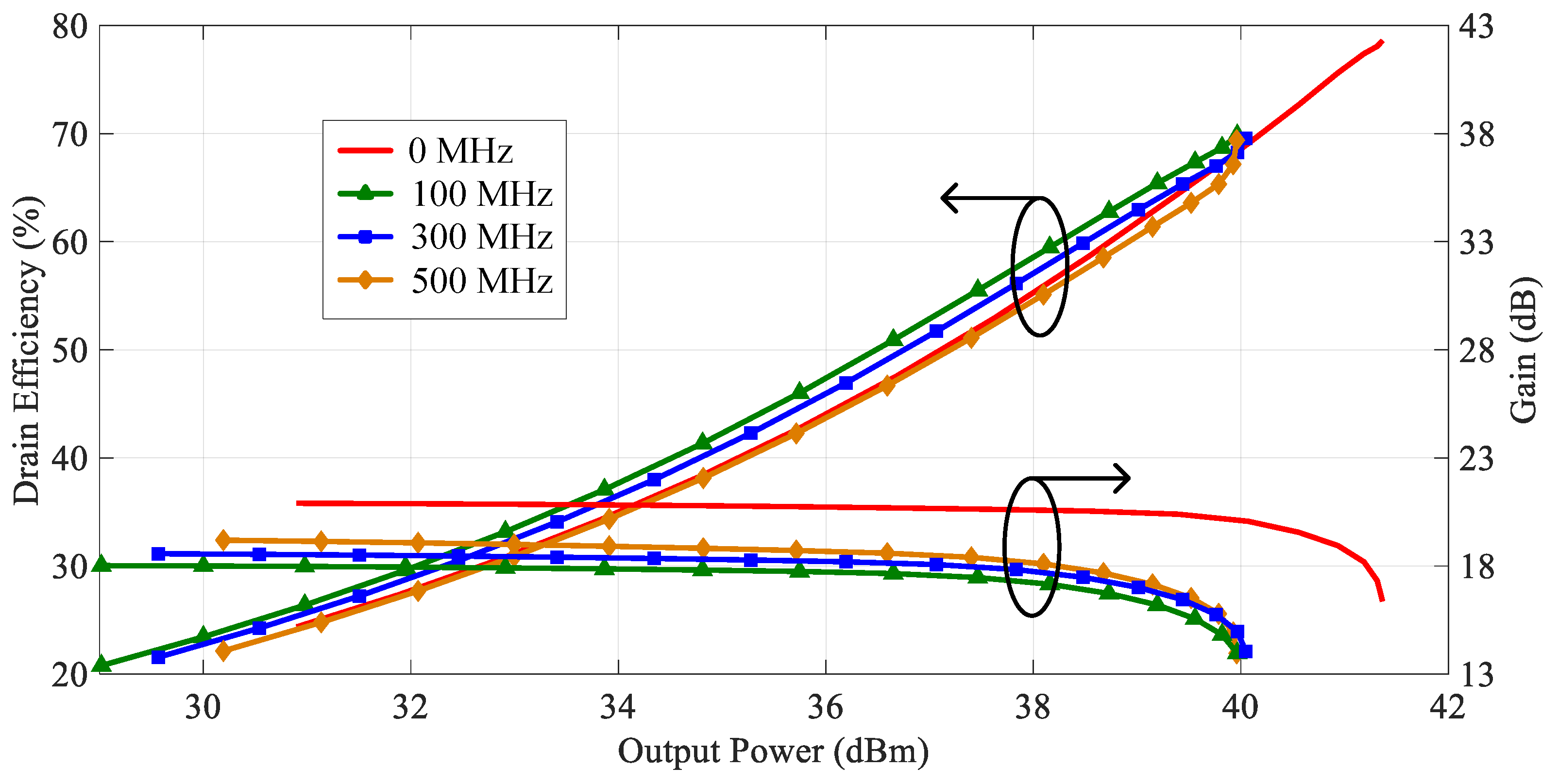
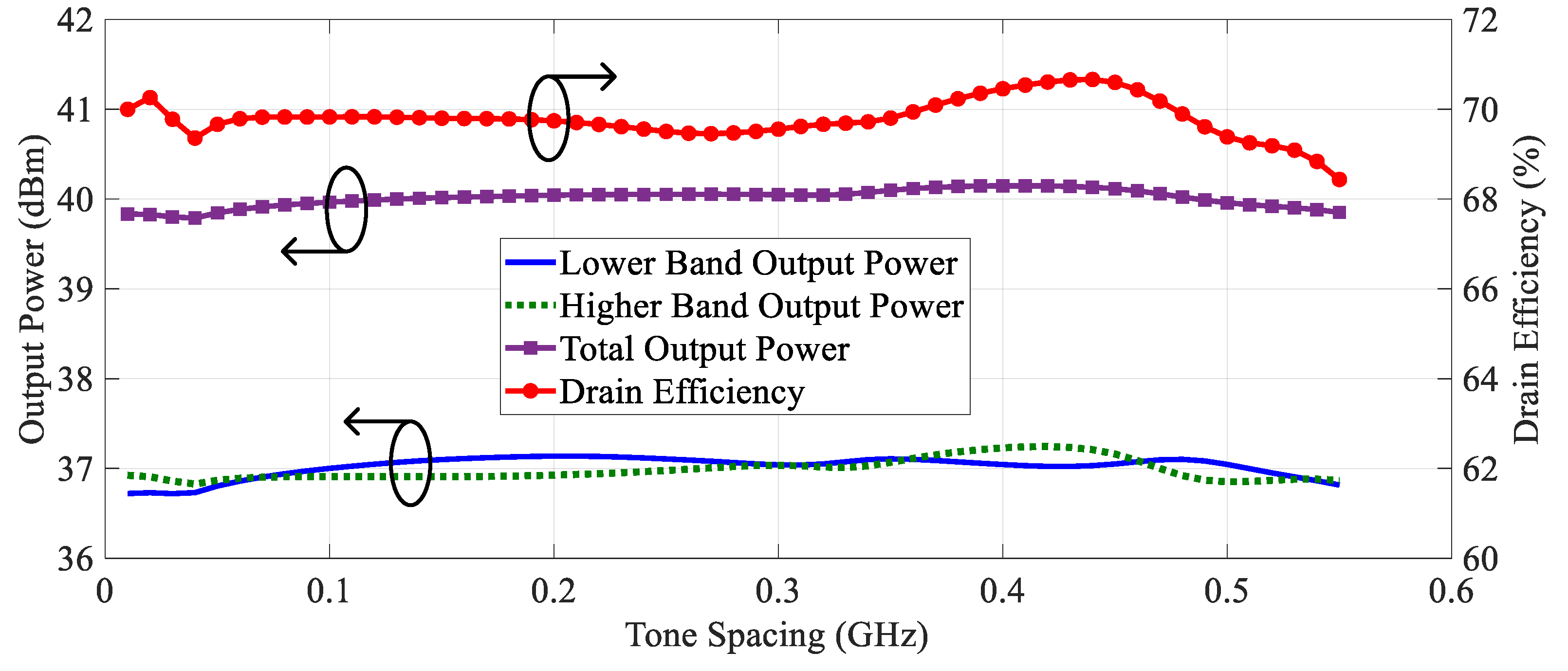


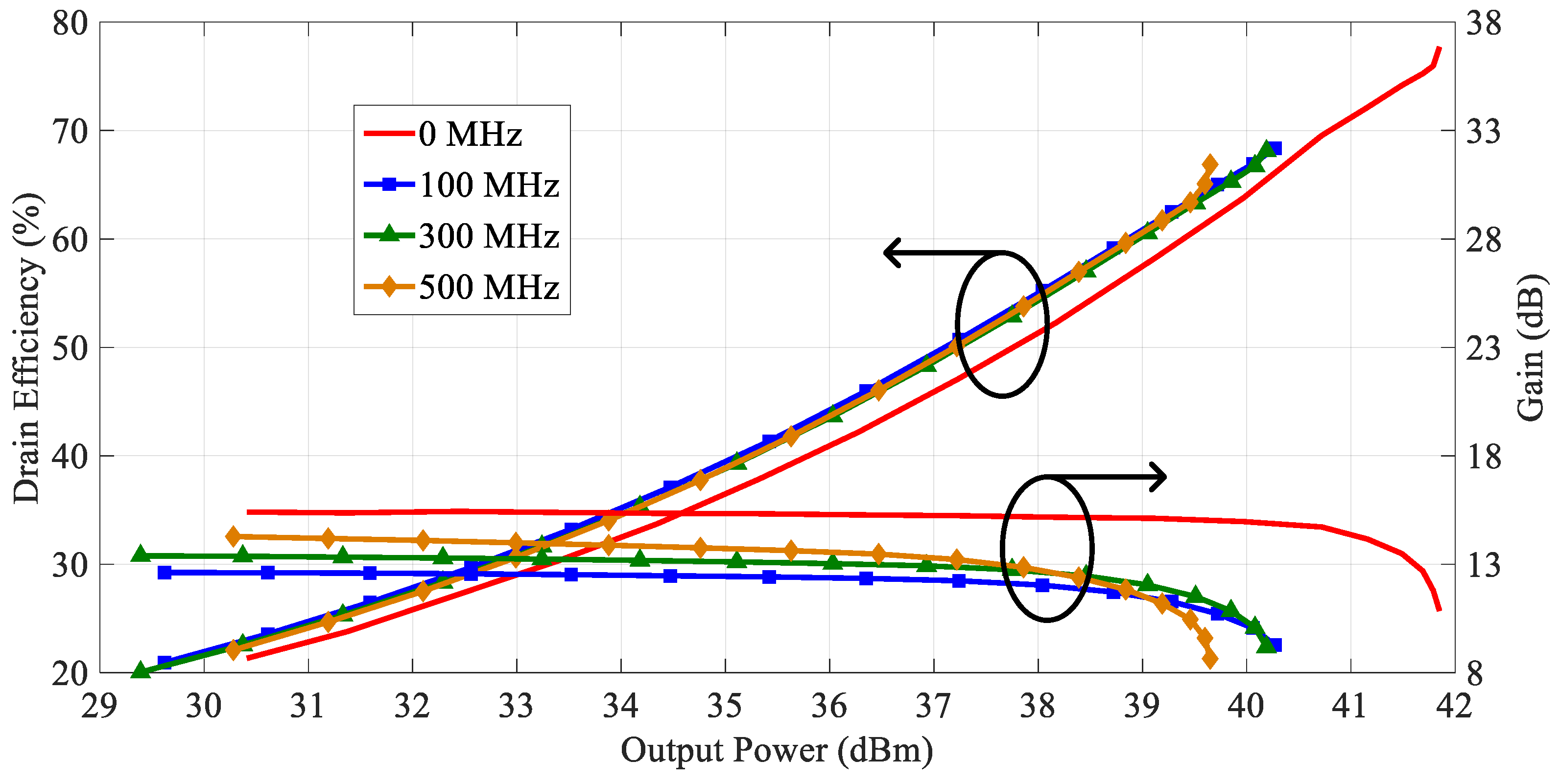

| Ref. (Year) | Single-Tone CW Signal | Concurrent Two-Tone CW Signal | |||||
|---|---|---|---|---|---|---|---|
|
Frequency (GHz) (FBW) |
Power (dBm) | (%) | Gain (dB) |
Tone Spacing (MHz) |
Power (dBm) | (%) | |
| [10] 2013 | 1.9/2.6 (N/A) | 41.5/41.5 * | 75/70 * | 10.2/11 * | 700 | 39.7 * | 63 * |
| [12] 2020 | 2.5/3.7 (N/A) | 41.8/41.2 | 77.5/71.9 | 10.3/11.2 * | 1200 | 40.1 | 62.6 |
| [16] 2020 | 1.9/2.35 (N/A) | 43.7/43.1 | 73.9/60.3 | 12.3/10.6 | 450 | 42.1 | 60.4 |
| [17] 2019 | 1.842/2.655 (N/A) | 41/40.5 | 73.5/71.7 | 11/10.5 | 813 | 39.5 * | 60 |
| [14] 2018 | 1.8–2.2 (20%) | 49.5–50.5 * | 70–74 * | N/A | 0–400 | N/A | 60–67 * |
| [18] 2025 | 1.8–2.2 (20%) | 41.1–42.4 | 61.8–67.3 | 14.8–16.3 | 0–400 | 40.0–40.6 | 60.0–64.0 |
| This Work | 1.75–2.25 (25%) | 40.9–42.0 | 63.3–77.3 | 11.7–12.9 | 0–500 | 39.6–40.3 | 66.2–68.8 |
Disclaimer/Publisher’s Note: The statements, opinions and data contained in all publications are solely those of the individual author(s) and contributor(s) and not of MDPI and/or the editor(s). MDPI and/or the editor(s) disclaim responsibility for any injury to people or property resulting from any ideas, methods, instructions or products referred to in the content. |
© 2025 by the authors. Licensee MDPI, Basel, Switzerland. This article is an open access article distributed under the terms and conditions of the Creative Commons Attribution (CC BY) license (https://creativecommons.org/licenses/by/4.0/).
Share and Cite
Ma, X.; Liu, F.; Fan, S.; Liu, X.; Liu, X.; Shi, W. Design of Broadband Power Amplifier with Enhanced Concurrent Efficiency for Wireless Communication. Electronics 2025, 14, 4220. https://doi.org/10.3390/electronics14214220
Ma X, Liu F, Fan S, Liu X, Liu X, Shi W. Design of Broadband Power Amplifier with Enhanced Concurrent Efficiency for Wireless Communication. Electronics. 2025; 14(21):4220. https://doi.org/10.3390/electronics14214220
Chicago/Turabian StyleMa, Xiaomin, Fan Liu, Songhai Fan, Xi Liu, Xiaojiang Liu, and Weimin Shi. 2025. "Design of Broadband Power Amplifier with Enhanced Concurrent Efficiency for Wireless Communication" Electronics 14, no. 21: 4220. https://doi.org/10.3390/electronics14214220
APA StyleMa, X., Liu, F., Fan, S., Liu, X., Liu, X., & Shi, W. (2025). Design of Broadband Power Amplifier with Enhanced Concurrent Efficiency for Wireless Communication. Electronics, 14(21), 4220. https://doi.org/10.3390/electronics14214220







